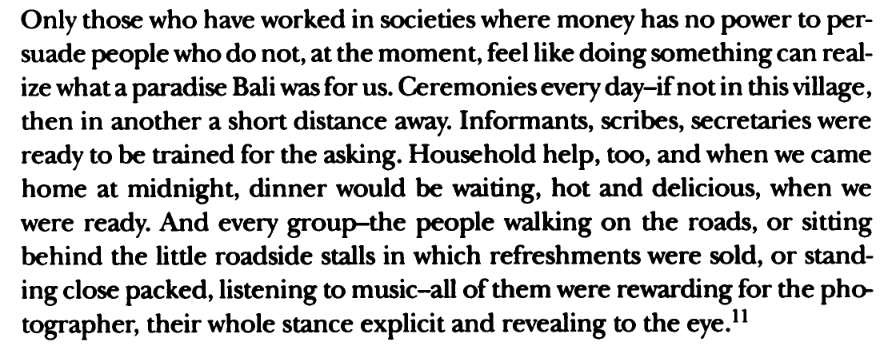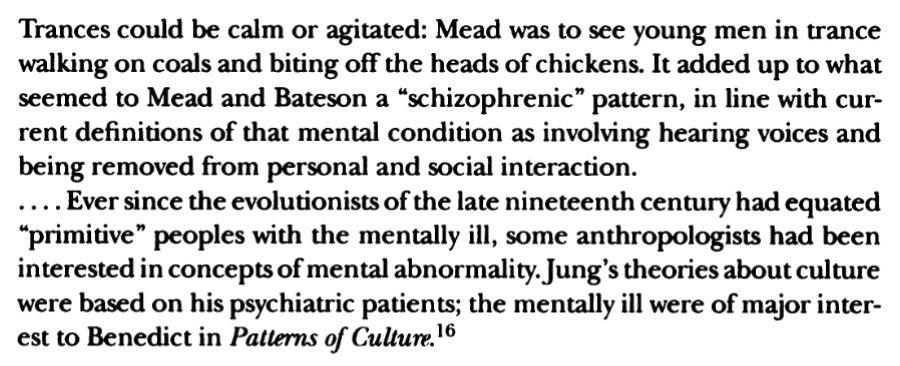...What is the process of conversion of a spiritual act such as trance into what Mead and Bateson saw as the objective recording of reality of the photograph or film?...
Wijaksuma's reading of the European view of Bali:
For us Bali is the place where everything is holy — we pray to the gods, as well as to the plants, the animals, and the flowers. That's our religion. But for them Bali is a paradise because they have a beautiful house, many servants, beautiful gamelan, a lot of food. And they have the girls with the bare breasts.And Margaret Mead herself:

(It's worth noting that the film was partly funded by the Committee for Dementia Præcox [that is, Schizophrenia], withn the objective of demonstrating that Balinese culture itself was schizophrenic)

=====
And moving on to private ritual:
I (the cynical and standoffish outsider) am deeply suspicious of public, organized, collective ritual, so much of which seems to me empty form, (quasi-)spiritual play-acting, cosplay routines alleged and supposed to unite the participants by routines of manipulated symbols... from which the participants may draw something that I am missing and am prone to disparage. The reciting of the Pledge of Allegiance and the foofaraw around the singing of the National Anthem are cases in point. I find exploration of personal 'ritual' behavior much more interesting: the repeated actions in which one finds balance, comfort, solace —and which at their extremes may be pathological.
Public ritual performances are exercises in participation: displays of belonging, believing, being seen by others... and in perpetual danger of being formulaic, routinized, corrupted by hieratic meddling ...EMPTY mumbo-jumbo.
The problem with public ritual comes when priests involve themselves and liturgies and vestments come to seem essential to the Enactment: it becomes theatrical, dependent on formalized illusion and Men Behind the Curtain, manipulating Levers...
Collective ritual, whether sacred or secular, has for me an Orwellian mind-control sense, where myth and official version and lip-service, and go-along-to-get-along kneejerk belief, is the glue that holds the structure together. That glue has a heavy fraction of hypocrisy mixed in to its hierarchies of sanctity and We/They separation: the ickier parts of Culture and Society
This morning I started to read Paul Theroux' The Old Patagonian Express: By Train Through the Americas and found this, describing what he saw from the train window as he left Boston, headed westward:
...repeatedly, American flags —the Stars and Stripes flying over gas stations and supermarkets and in numerous yards... The flags puzzled me: were these pious boasts of patriots or a warning to foreigners or decorations for a national holiday? And why, in the littered yard of that rundown house, was a pretty little flag flapping loyally from a pole? On the evidence here, it seemed an American obsession, a kind of image worship I associated with the most primitive political minds... (pg 8)I got to wondering about my first exposures to ritual, and came up with some early memories. The very first datable memory was of VJ Day, August 1945 (a few weeks before my second birthday) when Brother John and I went to ring the church bell at noon (all of Cambridge's churches rang their bells in ritual celebration of the End of The War). Another ghost of memory reminded me of an illustration in a book, dimly recalled but quite clear, showing British bomber pilots touching a good luck talisman as they embarked on a WW II sortie. Gradually the book came back to me: its red cover, the fact that it was about a homing pigeon whose release with a message when the bomber went down led to the rescue of the crew... a few minutes of searching turned up the glorious tale of Winkie, the pigeon who won the Dickin Medal in 1943 (and lives on, stuffed, in a museum in Dundee) ...and the book's title came to me: Watching for Winkie, and sure enough I was able to find a copy via Amazon, and will soon be reunited with it.
I also realized that my family of origin was TIED to the weekly ritual observance in the Sweet and Gorgeous Church (where the bell was, and where my father conducted the Sunday services)

(the Sweet and Gorgeous in 2007, among Harvard buildings)
...and I remembered the setting in detail, replete with church-like smell and the texture of the kneeling furniture and the padding of the pews, and which pew was OUR pew, and the parameters of my mother's church attire, and the organ and two kinds of music: the hymns, and the display of the organist's artistry. There were responsorials and unison performances of liturgical texts, some of them ritual prayers, others affirmative of commonly-held convictions. And there was the Sermon, from which I was excused, and so was not a party to whatever it was that my father SAID to the congregation. And who WERE those Swedenborgians who turned up every Sunday? What did they come for?Any repeated action is on its way to becoming a ritual. All it needs is semiotic content (being invested with meaning), not unlike Terry Pratchett's formula for Belief (see Small Gods for the clearest exposition) as the lifeblood of the gods: the more believers, the more powerful the god, and conversely.
Fact is, ritual is all around us, expressed in architectural styles, in the procedures for the naming of boats, in the yellow line down the middle of the road, in the shape of the mailbox, in the finer points of household display (in and out), in the shopping lists and the shopping itself, and surely in one's cherished daily routines. We take comfort in the measured exercise and performance of those things, in their orderliness and adherence to the convention, and we're acutely able to detect departures from the expected forms.
A lot of what we do has substantial ritual content: there are procedures that are just right, how xxx ought to be done; some are trivial, some are vitally important. And some are annoying to others who may be in the vicinity of the performance of some personal ritual: they may not grasp the centrality to you of the rituals you enact. I reviewed my own morning rituals, discovering how very elaborate they are, how idiosyncratic, and how essential they seem to be to my own satisfaction. The morning ritual is choreographed, and one is persnickety in the extreme and to a fault. And there's no audience.
The Hidden Powers of Everyday Ritual | The MIT Press Reader (Bradd Shore)
A "ritual" comes into being when ordinary behavior is repeated until it begins to harden into recognizable action patterns we call "routines." Routines are efficient ways of getting jobs done by creating sets of automated, repeatable actions. Routines simplify our lives by offloading complex actions from working memory, so we do them without much cognitive effort. Our morning grooming routine gets us ready for the day. Our house-cleaning routines simplify keeping our living spaces in order by turning a series of actions into a semi-automatic action set. Routines are behavior on automatic pilot.But once our acts have crystallized into a fixed routine, they may keep evolving, taking on symbolic significance and adding layers of meaning to our actions — this is called "ritualization." We can think of rituals as routines with a significant symbolic load.
...Watch any video of people dancing ecstatically or a crowd chanting rhythmically. You are watching agency reversal in action.
In an ecstatic ritual performance, the power of the rhythmic action reverses the experience of who's doing the action. Dancers may begin by feeling that they are dancing, but as the pulse of the action intensifies, there comes a point of reversal, when the dance starts performing the dancer. The ritual takes over. In intense sports, such reversal is known as an experience of "flow." While only an especially intense ritual produces the total reversal we know as trance, where the performer is carried away, all ritual conveys some degree of agency reversal.
As a socializing mechanism, agency reversal can create a powerful bonding experience among performers. Military ritual comes to mind. In religious rituals, agency reversal is the closest humans come to a sense of contact with a transcendent agent...
...Something done once is just an act. Done twice, it is a repeat. But beyond that lies the endless expanse of ritual. "This is what we do together." "We always do that." "We used to eat here." "This is who we are."
...And finally, there are the miraculous powers of individual rituals, which can provide a surprising sense of peace and comfort in the face of sorrow, loneliness, or stress. Consider the power of an evening cup of tea enjoyed in a favorite teacup. Quickly, "a cup of tea" becomes "my cup of tea" as you take a simple act to heart. Ritualization is a potent stabilizing agent, a simple salve for a stressful time if only we are mindful of how we use its powers.
'Personal ritual' can be thought of as balm to the spirit and even as an expression of joy, but not so far away in semantic space is 'obsession', in the pathologic extreme of OCD.
(these don't have much to do with ritual)
(probably)
(ummmm... but....)
Parmesan roast cauliflower
Whole roast cauliflower
Billy Strings and Bryan Sutton
Sitting down like a shishi lion
Zen Master Gu Ja